Which of the 12 Iconic Nativity Scene Paintings Is Your Favorite?
The Nativity scene, a scene of course that’s very very familiar and you can see them in churches everywhere in moles around Christmas, and maybe you have one at home as well. Today, I’d like to talk about something about these scenes in art-Nativity scene painting.
The nativity scene painting, also known as the “Adoration of the Shepherds” or the “Adoration of the Magi,” is an artistic representation of the birth of Jesus Christ, dating back to early Christianity, with notable developments during the Middle Ages and the Renaissance. Artists like Domenico Ghirlandaio, Caravaggio, Sandro Botticelli, and Hugo van der Goes, among others, all created works on the subject. These paintings are more than just religious symbols; they are masterpieces that showcase the evolution of art and the enduring power of the nativity story.
In this article, I would like to share 12 Iconic Nativity scene paintings, each with its own story and artistic merit. If any amazing Nativity scene art paintings are missing, feel free to add them in the comments. I’d be very interested to know what your favorite nativity scene paintings are!
- Famous Nativity scene paintings
- 1. Adoration of the Magi (Gentile da Fabriano)
- 2. Saint Columba Altarpiece (Rogier van der Weyden)
- 3. Adoration of the Magi (Sandro Botticelli)
- 4. Portinari Altarpiece (Hugo van der Goes)
- 5. The Adoration of the Shepherds (Domenico Ghirlandaio)
- 6. Nativity at Night (Geertgen tot Sint Jans)
- 7. The Mystical Nativity (Sandro Botticelli)
- 8. The Adoration of the Shepherds (Giorgione)
- 9. The Holy Night (Antonio da Correggio)
- 10. The Nativity (Federico Barocci)
- 11. Nativity with Saint Francis and Saint Lawrence (Caravaggio)
- 12. The Adoration Of The Shepherds (Gerrit van Honthorst
- Conclusion
Famous Nativity scene paintings
1. Adoration of the Magi (Gentile da Fabriano)
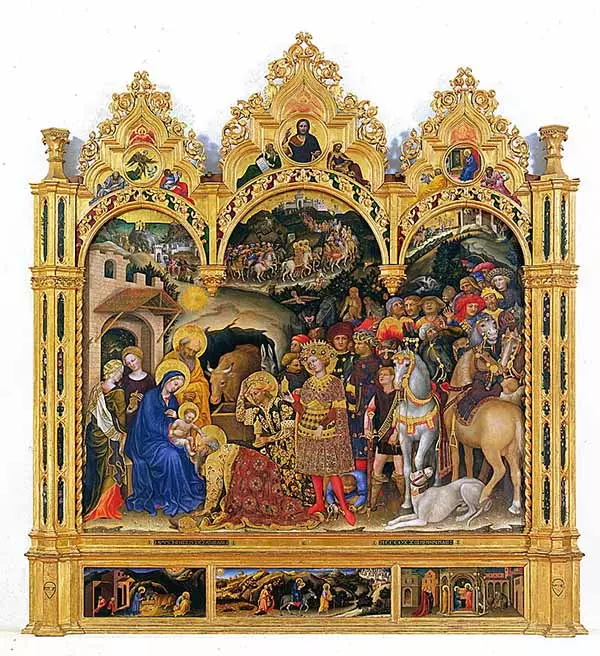
Gentile da Fabriano’s “Adoration of the Magi” is a stunning example of the International Gothic style. Painted in 1423, this masterpiece is housed in the Uffizi Gallery in Florence. Because of its style and the spire at the top of the frame, the painting is considered an example of International Gothic.
The composition is rich with figures, including the three Magi, who are depicted in lavish robes and intricate crowns. The scene is set against a backdrop of mountains and a bustling city, adding a sense of grandeur and narrative depth. The use of light and shadow, along with the meticulous rendering of textures, showcases Fabriano’s skill and attention to detail. The figures are not static but appear to be engaged in a lively procession, emphasizing the joyous occasion of Jesus’ birth.
2. Saint Columba Altarpiece (Rogier van der Weyden)
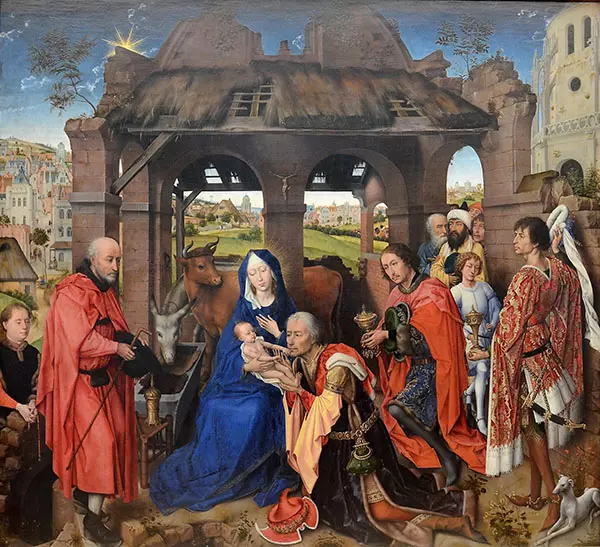
Rogier van der Weyden’s “Saint Columba Altarpiece” is a triptych created around 1450-1455, now housed in the Alte Pinakothek in Munich. The central panel of this altarpiece depicts the nativity scene, surrounded by scenes of the Annunciation and the Presentation in the Temple.
This is one of my favorites. Firstly, of course, the use of light and shadow in this painting is undoubtedly a masterpiece, and Van der Weyden’s paintings are always known for their emotional intensity and meticulous detail. But what appeals to me the most? The background. As you gaze at the painting, you can see a Jesus Crucifix in the background. Wow, that’s interesting. Of course, this isn’t some time traveler, this is a technique we call foreshadowing, a common occurrence in artwork from this era.
This painting of baby Jesus’ nativity with his crucifix in the background is a perfect example of why people love it. The combination of vibrant colors and the small details make this piece stand out from others in the same genre.
3. Adoration of the Magi (Sandro Botticelli)
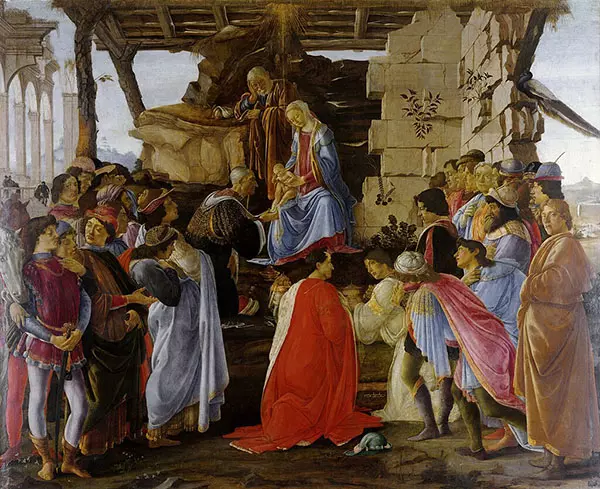
Sandro Botticelli’s “Adoration of the Magi” is a masterpiece of the Early Renaissance, painted around 1475-1476 and displayed in the Uffizi Gallery in Florence.
Unlike many of the early paintings depicting stables, Botticelli chose to place the scene in the dilapidated ruins of Rome, and in the center of this building, he placed a solid rock for Mary and Jesus to sit high above their visitors. With this decision, Botticelli seems to be saying that Christianity will be built on something stronger than Rome.
Botticelli’s use of perspective creates a sense of depth, with the figures arranged in a pyramidal structure. The three Magi are depicted with a sense of individuality, each bearing unique expressions and gestures.
4. Portinari Altarpiece (Hugo van der Goes)
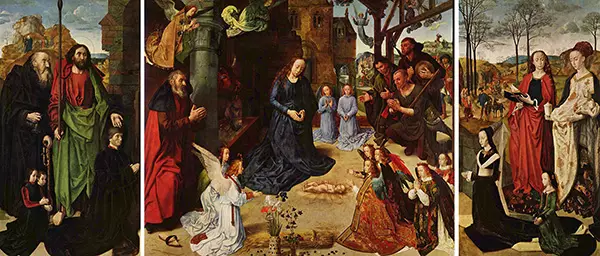
Hugo van der Goes’ “Portinari Altarpiece,” created between 1475-1476, is a monumental triptych housed in the Uffizi Gallery in Florence. The central panel depicts the nativity scene with an extraordinary level of detail and symbolism.
Many things make this painting special: Mary great with child walking with Joseph in the background, the scene where angels arrive to tell the shepherds the news of Christ’s birth, and Jesus radiating light, etc. But what struck me most was the shepherds in the painting.
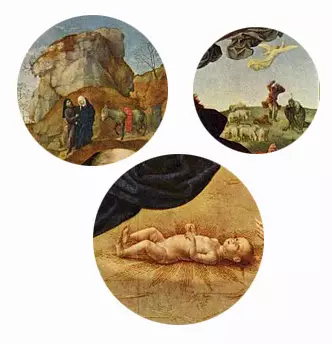
First, they are painted large giving them the same importance as the Holy Family. This was shocking to the audiences who first viewed the work. These common shepherds are granted a key role. Also, shocking to the original audience was the realistic portrayal of the shepherds. This realism made waves in the art world. It’s really my favorite part. Normally people particularly commoners were depicted in a very generalized fashion, not as unique individuals. yet here we see a unique group of very distinctive men.
5. The Adoration of the Shepherds (Domenico Ghirlandaio)
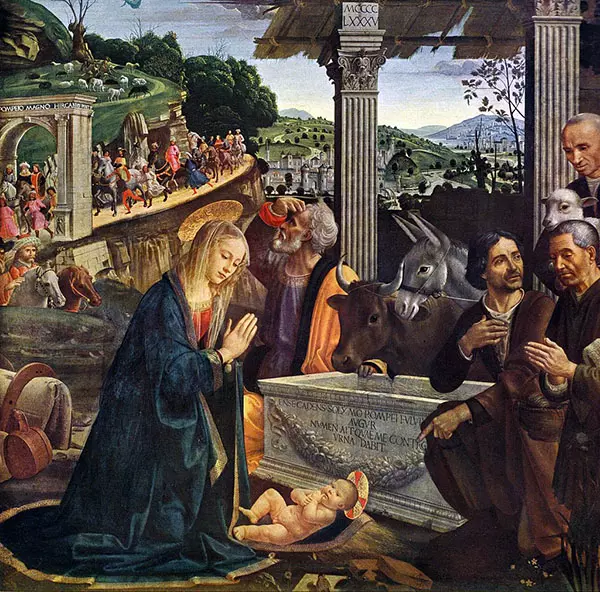
Domenico Ghirlandaio’s “The Adoration of the Shepherds,” painted in 1485, is located in the Sassetti Chapel of the Basilica Santa Trinita in Florence, Italy. This fresco is a prime example of the Italian Renaissance’s emphasis on naturalism and perspective.
The composition is centered around the infant Jesus, with Mary and Joseph in adoration. The shepherds are depicted with a sense of realism, their worn clothes and humble demeanor contrasting with the divine presence of the angels. The background features a detailed landscape, adding depth and context to the scene.
Ghirlandaio’s use of color and light creates a harmonious and balanced composition. The fresco’s naturalistic details, from the expressions on the faces to the textures of the garments, demonstrate the artist’s mastery of the human form and his ability to convey emotion.
6. Nativity at Night (Geertgen tot Sint Jans)
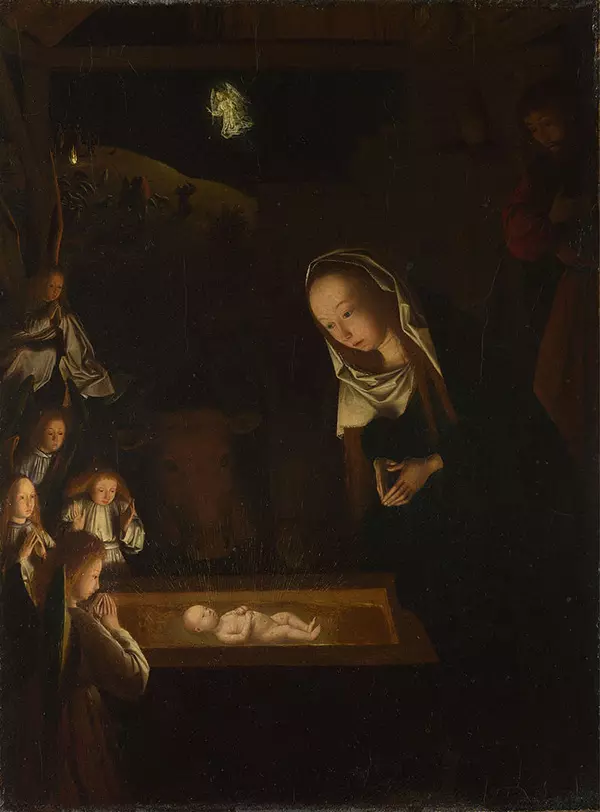
Geertgen tot Sint Jans’ “Nativity at Night,” painted around 1490, is a luminous masterpiece housed in The National Gallery in London.
Like many nativity paintings, this one was influenced by a vision of St Bridget of Sweden, a very popular mystic:
… The Blessed Virgin knelt in prayer in a reverent posture, with her back to the manger …… As she stood praying, I saw the fetus in her womb move, and suddenly she gave birth to her Son, who radiated an ineffable light and splendor, which the sun could not compare with, nor could the candles that St Joseph had placed there illuminate, and the divine rays annihilated The material light of the candle …… I saw the glorious infant lying naked and shining. His body was pure, without any dirt or impurity. Then I also heard the angels singing, which was magical and sweet ……
The scene is set at night, with the infant Jesus serving as the primary light source. This creates a dramatic contrast between the dark surroundings and the radiant figures. Mary and Joseph are depicted in reverent poses, their faces bathed in the soft glow emanating from the baby Jesus. That reminds me “In your light, we see light”.
7. The Mystical Nativity (Sandro Botticelli)
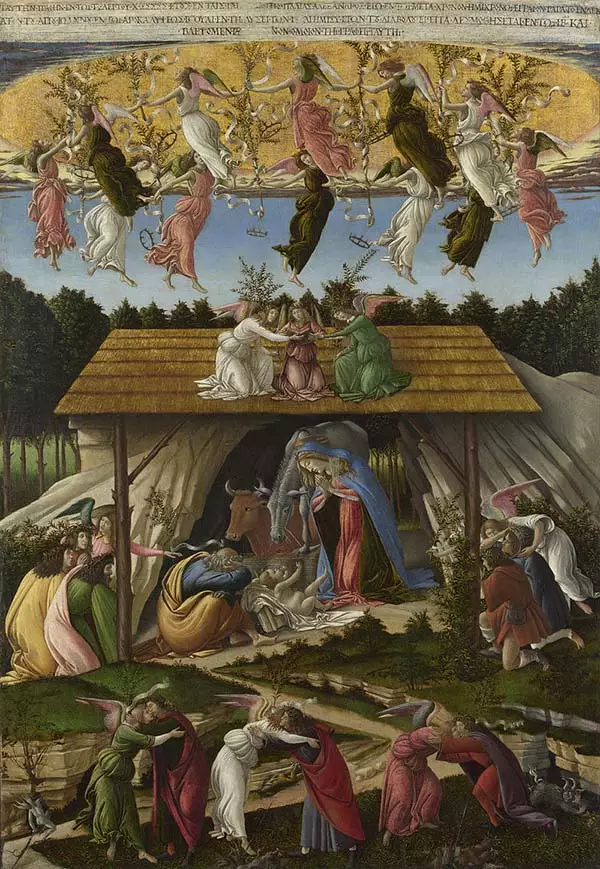
Sandro Botticelli’s “The Mystical Nativity,” created around 1500-1501, is a unique and enigmatic work housed in the National Gallery in London. Bodicelli had a clear understanding of linear perspective, how to use a consistent light source, and how to mold a figure with mass. In this painting, however, he ignores these principles.
The scene depicts the nativity with a host of angels and figures in adoration. Above the scene, angels are shown dancing in a circle, symbolizing the divine celebration. The setting is a lush and verdant landscape, with the Holy Family at the center, surrounded by a golden aura.
At first glance this work appears to be a joyous Christmas celebration, however, as we move down the painting, a dark element emerges. influenced by Dante’s concepts of heaven and hell, at the bottom of the picture, demons are disappearing into the ground, and angels and humans rustling about. This is not a Christmas card Nativity scene as we know it, but a representation of spiritual struggle. While there is joy and celebration, there is also pain.
The mystical nativity is primarily about peace. Through the coming of Christ, his first and second advent, evil has disappeared, and peace reigns. I read this work as a message of faith hope and love.
8. The Adoration of the Shepherds (Giorgione)
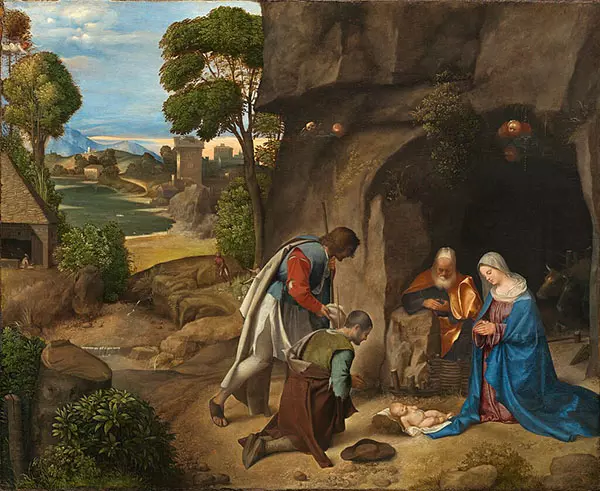
Giorgione’s “The Adoration of the Shepherds,” painted between 1505-1510, is a masterpiece of the High Renaissance, housed in the National Gallery of Art in Washington, D.C. This painting is notable for its serene composition and naturalistic details
The scene is set in a rustic landscape, with the Holy Family placed in the foreground. The shepherds are depicted with a sense of humility and reverence, their simple attire contrasting with the divine presence of the infant Jesus. The background features a detailed landscape, the colors and forms of both the landscape and the monuments are united by the mastery of Giorgione. The shepherds, the Virgin Mary, and St Joseph converge on the Son. Likewise, the landscape converges on this sacred scene. Judging by the Son’s gestures, he also responds to those who believe in him. Likewise, the landscape is infected by the mood at the center of the miracle, becoming more and more harmonious and luminous. There seems to be a similar pattern between the viewer and Giorgione’s work…
9. The Holy Night (Antonio da Correggio)
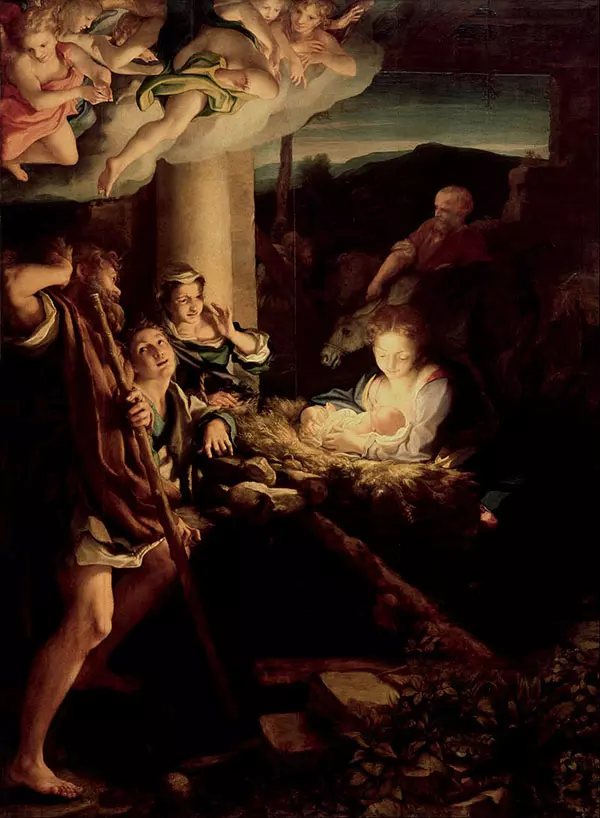
Antonio da Correggio’s “The Holy Night (Adoration of the Shepherds),” painted around 1529-1530, is a masterpiece of the Italian Renaissance, housed in the Gemäldegalerie Alte Meister in Dresden.
This work is best known for its use of light. It pointed the way for future Lombard studies of luminous effects, modeled by painters such as Camillo Procaccini, Luca Cambiasi, Guido Reni, and Domenichino.
The scene is set in a humble stable, with the Holy Family at the center. The shepherds are depicted in various poses of adoration, their expressions conveying a sense of wonder and reverence. The image of the child is the luminous fulcrum of the whole composition, while the light, which is weakly reflected in the surrounding figures, is the absolute protagonist of the picture.
10. The Nativity (Federico Barocci)
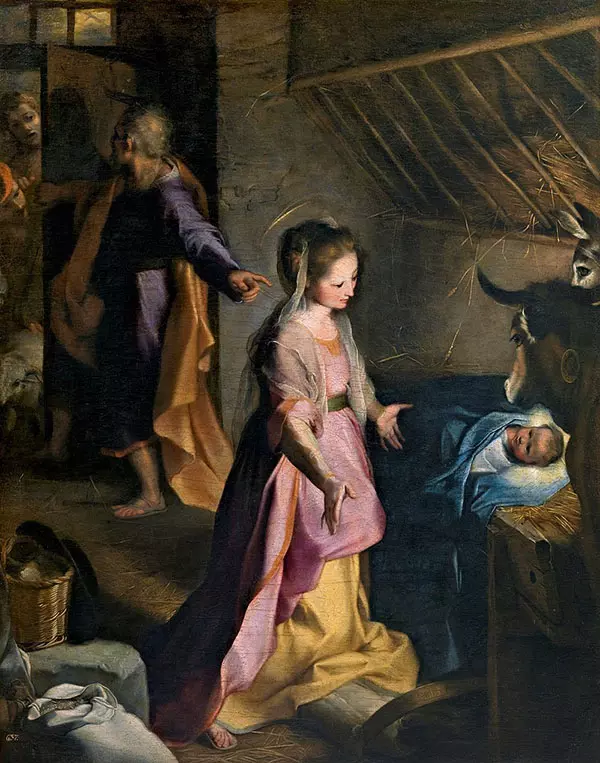
Federico Barocci’s “The Nativity,” painted in 1597, is a luminous masterpiece housed in the Museo del Prado in Madrid.
What characterizes and makes this work unique is the extraordinary nocturnal effect: the light is released by the Child Jesus, a divine light, which spreads in the hut and invests the figure of Mary. who enraptured contemplates the Child. This spectacular use of light is achieved thanks to small brush strokes and sight color overlays, which envelop the whole scene in a trembling atmosphere and give an iridescent appearance to the Virgin’s robe.
11. Nativity with Saint Francis and Saint Lawrence (Caravaggio)
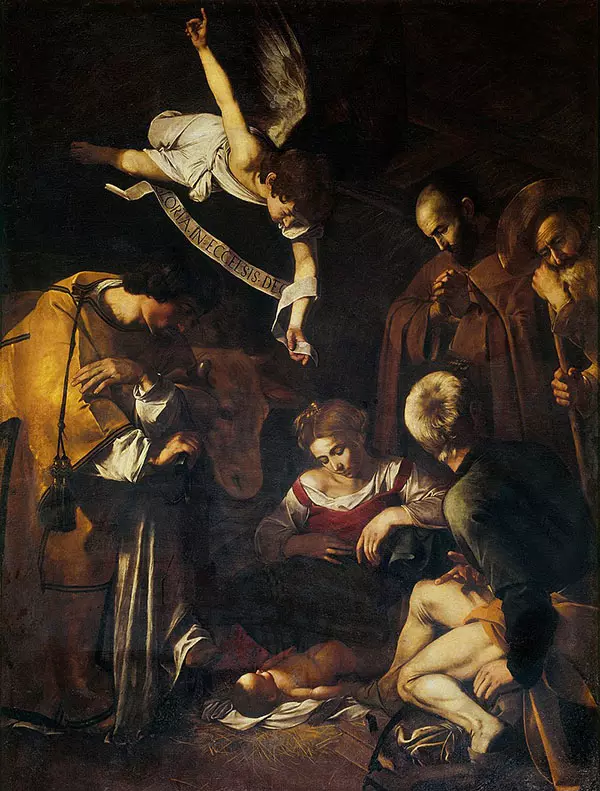
Caravaggio’s “Nativity with Saint Francis and Saint Lawrence,” painted in 1609. This painting is notable for its intense contrasts between light and shadow.
Upon first glance, this work appears to be a fairly traditional Nativity scene. The Christ child is lying on the ground in a bed made of hay. The Virgin Mary looks adoringly down at her son, Joseph and a Shepherd appears to be discussing the birth. flying in from the left-hand corner, an angel proclaims the birth of the son of god. Viewers can see the typical Caravaggio markers quite well in this piece. Firstly is the dramatic use of light and shadow called tenebrism, the artist also utilized twisting forms and a compact composition to tell the story.
The theft case certainly made this work more widely known. It is missing in 1969 from the Oratory of Saint Lawrence. Investigators believe the painting changed hands in the Sicilian mafia in the decades following the theft and may still be in hiding. A replica was commissioned in 2015 and now hangs on the altar.
As of 2005, the FBI has named the Nativity with Saints Francis and Lawrence as one of its top 10 art crimes. The bureau puts his value at around 20 million.
12. The Adoration Of The Shepherds (Gerrit van Honthorst
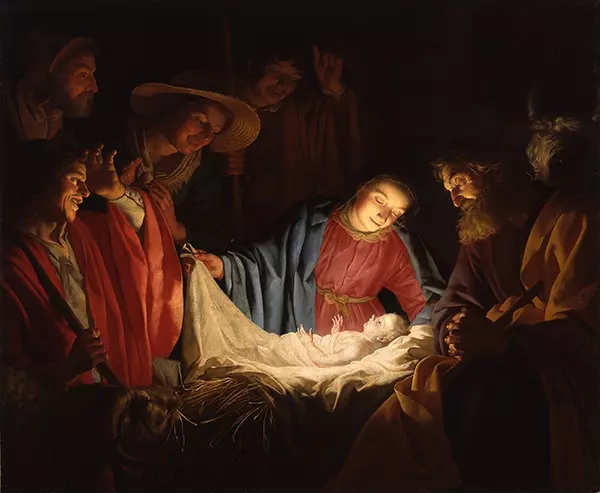
Gerrit van Honthorst’s “The Adoration Of The Shepherds,” painted in 1620.
I absolutely love this painting and how the artist shows the peace and Serenity of Mary and Joseph and their utter joy and generosity in sharing the Christ child with those who visit. We see Jesus as Mary in the act of pulling away his blankets to show him to others as the source of light. In this image, he is the light in the darkness as John’s Gospel. The bystanders have various experiences, one is filled with total joy, while another seems to show such a wondering reverence for what is before him that he is his hands folded in prayer.
The painting was included in the Uffizi and, unfortunately, was damaged during the Via dei Georgofili Massacre in 1993. Gerrit van Honthorst produced a similar painting in 1622, which is now in the Wallraf-Richartz-Museum.
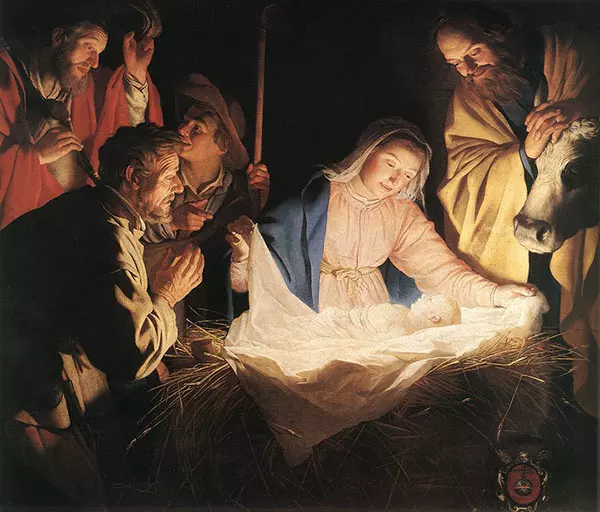
Conclusion
The nativity scene painting is more than just a religious symbol; it is a testament to the enduring power of the nativity story and its influence on art. Each of the 12 iconic paintings we have explored reflects the artistic trends and cultural contexts of its time, showcasing the evolution of Christian art.
